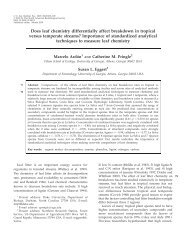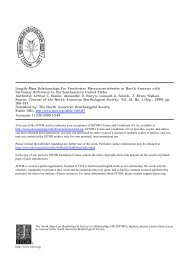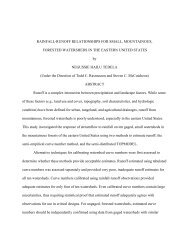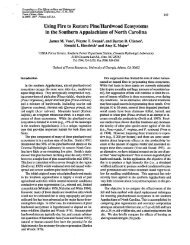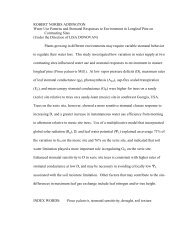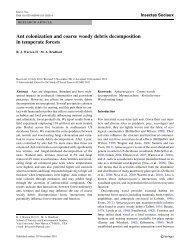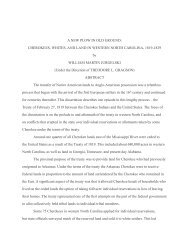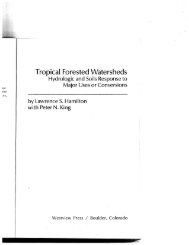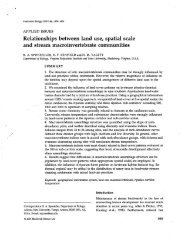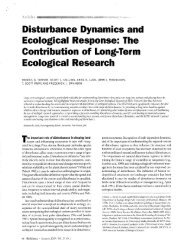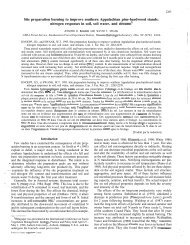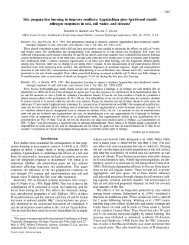biology join - Coweeta LTER - University of Georgia
biology join - Coweeta LTER - University of Georgia
biology join - Coweeta LTER - University of Georgia
Create successful ePaper yourself
Turn your PDF publications into a flip-book with our unique Google optimized e-Paper software.
Articles<br />
The Disappearing Cryosphere:<br />
Impacts and Ecosystem Responses<br />
to Rapid Cryosphere Loss<br />
Andrew G. FountAin, John L. CAmpbeLL, edwArd A. G. SChuur, ShAron e. StAmmerJohn,<br />
mArk w. wiLLiAmS, And huGh w. duCkLow<br />
The cryosphere—the portion <strong>of</strong> the Earth’s surface where water is in solid form for at least one month <strong>of</strong> the year—has been shrinking in response<br />
to climate warming. The extents <strong>of</strong> sea ice, snow, and glaciers, for example, have been decreasing. In response, the ecosystems within the cryosphere<br />
and those that depend on the cryosphere have been changing. We identify two principal aspects <strong>of</strong> ecosystem-level responses to cryosphere loss:<br />
(1) trophodynamic alterations resulting from the loss <strong>of</strong> habitat and species loss or replacement and (2) changes in the rates and mechanisms <strong>of</strong><br />
biogeochemical storage and cycling <strong>of</strong> carbon and nutrients, caused by changes in physical forcings or ecological community functioning. These<br />
changes affect biota in positive or negative ways, depending on how they interact with the cryosphere. The important outcome, however, is the<br />
change and the response the human social system (infrastructure, food, water, recreation) will have to that change.<br />
Keywords: cryosphere, ecosystem response, environmental observatories<br />
Global average air temperature has warmed by 1 degree<br />
Celsius (°C) over the past century, and in response, the<br />
cryosphere—the part <strong>of</strong> the Earth’s surface most influenced<br />
by ice and snow—is changing. Specifically, alpine glaciers<br />
are retreating, the expanse <strong>of</strong> Arctic sea ice has been shrinking,<br />
the thickness and duration <strong>of</strong> winter snowpacks are<br />
diminishing, permafrost has been melting, and the ice cover<br />
on lakes and rivers has been appearing later in the year and<br />
melting out earlier. Although these changes are relatively<br />
well documented, the ecological responses and long-term<br />
consequences that they initiate are not. Detailed studies<br />
have identified specific responses to individual components<br />
cryospheric changes (e.g., polar bear habitat and sea ice<br />
loss), but a more integrated view across many landscapes<br />
and types <strong>of</strong> changes has been lacking. In the present article,<br />
we draw largely—but not exclusively—from sites <strong>of</strong> the US<br />
Long Term Ecological Research (<strong>LTER</strong>) Network (the special<br />
section in this issue; see especially Robertson et al. 2012) to<br />
synthesize our current knowledge <strong>of</strong> ecosystem responses<br />
to the changing cryosphere in an attempt to infer broad<br />
responses and to anticipate the further range <strong>of</strong> changes that<br />
we might expect. We contend that place-based, long-term,<br />
interdisciplinary efforts, such as <strong>LTER</strong>-type projects, are<br />
the best suited for tracking such changes and for detecting<br />
and understanding their cascading effects throughout the<br />
ecosystem.<br />
The cryosphere<br />
For the purposes <strong>of</strong> this synthesis, the spatial extent <strong>of</strong> the<br />
cryosphere for the Northern Hemisphere includes the mean<br />
February extent <strong>of</strong> snow cover (measured between 1987<br />
and 2003) and the mean March extent <strong>of</strong> sea ice (measured<br />
between 1979 and 2003). For the Southern Hemisphere, we<br />
include the mean August and September extents <strong>of</strong> snow<br />
and sea ice, respectively. Broad statistics for the cryosphere<br />
and its changes are provided in table 1 and are depicted in<br />
figure 1.<br />
Permafrost (figure 2a) is widespread in the Arctic and<br />
boreal regions <strong>of</strong> the Northern Hemisphere, with the permafrost<br />
zone occupying about 24% <strong>of</strong> the exposed land area.<br />
Most <strong>of</strong> this (78%) occurs in lowlands below 1000 meters<br />
(m) <strong>of</strong> elevation, whereas deposits <strong>of</strong> alpine permafrost<br />
are widely distributed. Changes in permafrost are typically<br />
documented by two metrics: temperature and the depth to<br />
the permafrost, which is defined as the active layer, which<br />
in turn is the surface layer that thaws seasonally. Since the<br />
1980s, permafrost temperatures have generally increased<br />
between 0.5° and 2°C when measured at about 10 m, a<br />
depth at which seasonal variations cancel each other out and<br />
thus yield a seasonally constant value (Romanovsky et al.<br />
2007). At some Russian sites, where many data are available,<br />
the active layer increased by 1.7–5.5 centimeters (cm)<br />
per year over the 10-year period between 1997 and 2007<br />
BioScience 62: 405–415. ISSN 0006-3568, electronic ISSN 1525-3244. © 2012 by American Institute <strong>of</strong> Biological Sciences. All rights reserved. Request<br />
permission to photocopy or reproduce article content at the <strong>University</strong> <strong>of</strong> California Press’s Rights and Permissions Web site at www.ucpressjournals.com/<br />
reprintinfo.asp. doi:10.1525/bio.2012.62.4.11<br />
www.biosciencemag.org April 2012 / Vol. 62 No. 4 • BioScience 405



